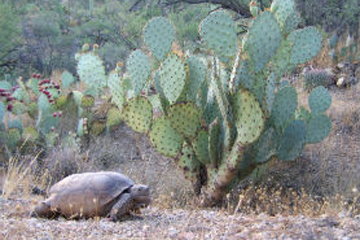
Great Desert Garbage Patches

Ocean garbage patches get a lot of attention, but a lot of trash is blowing across some of the most treasured and remote parts of America's desert wilderness, according to a new study out of the University of Arizona.
Biologist Erin Zylstra mapped and added up all the wind-dispersed plastic trash bags and latex balloons in two protected parts of the Saguaro National Park in Arizona. She was surprised to discover that these particular kinds of very mobile trash outnumbered desert tortoises and western diamondback rattlesnakes. Like in the oceans, the bags and balloons pose potential threats to wildlife.
The study, due to be published in the February 2013 issue of Journal of Arid Environments, grew out of surveys Zylstra was conducting on those same two reptile species as part of her studies at the University of Arizona, where she is now a doctoral student.
PHOTOS: The Great Atlantic Garbage Patch
"We were spending a lot of time surveying and we started to notice a lot of trash," Zylstra said. "Balloons are everywhere, once you start to look." The balloons were often found in clumps, tied with string and can become so degraded they look almost like lichens stuck to rocks, she explained.
"Western diamondback rattlesnakes are pretty common in the areas we studied," she said. "The fact that there is considerably more balloons than snakes was kind of shocking."
Like trash on the oceans and in coastal areas, winds seems to play a role in where trash collects in the desert as well. Zylstra found that the wind-blown bags and balloons in the two study areas, situated on opposite sides of the city of Tucson, reflected seasonal wind patterns in the region.
Sign up for the Live Science daily newsletter now
Get the world’s most fascinating discoveries delivered straight to your inbox.
Because balloons are made of latex, they eventually decompose, although how long that takes in the desert is unknown. Plastic grocery bags, on the other hand, only break down if they are exposed to sunlight. Even then they only break into smaller pieces and become part of the water and soils, without actually changing into other compounds. That means they could mix with the water and food ingested by wild animals.
"Nobody really knows where those pieces of plastic bags end up," Zylstra said. "It's not known whether they have toxic effects." One possible concern is that the bags could end up in the few desert watering holes that animals of all kinds must share.
Another potential hazard for wildlife is the strings that come with the bunches of balloons, said Don Swann, a National Park Service biologist who works at Saguaro National Park.
"We see plastic bags and balloons in very remote places," confirmed Swann. This study finally put numbers on the amount of trash, which is very helpful, he said. It also showed how efficiently trash surveys can be incorporated into biological surveys.
"It's really great when researchers think outside the box," said Swann. "They can come up with insights that are valuable to us."
This story was provided by Discovery News.









